|
Consider two events, you (detector, photomultiplier tube at B),
and them (light goes A to B via reflection), say.
By adding 1 unit of your clock to: their probability of their
event occuring in 1 unit of their clock, you get two clocks being
compared by their event-probability.
With light, the shortest-light-paths turn up more often as more
of those can fit in an interval of space-time.
You effectively treat your clock as having the same unit as their
clock. You get a sum of different densities of similarity-
concentration; within all possible events occuring in a unit of
their clock. A number called an "amplitude". Then square that
number and you get probability of the event occuring in an
interval of two matching 1-unit clocks.
Effectively you are using them to calibrate your clock to give a
space-time or time-space or time-time (inter-changeable concepts)
interval containing an actual real probability of their event
occuring.
Remember the classic diagram of a glass lense; with light rays
being bent more at the thin ends than at the thick center?
Apparantly you can regard the light as doing this even with no
glass lense there! But you don't see the bent paths as they take
longer, so there are more short paths per unit of your time than
long paths; you see the more frequent paths.
Put the glass lense there, and the thicker glass slows down those
short direct paths, and progressively as the glass thins it has
less slowing affect on all the paths.
So this makes all the paths take equal time to get to that little
spot; so the light-time is focused onto that little space, making
it bright all at once.
Lenses then don't bend light; they synchronise space-time; they
focus time on space; increasing self-reference for the light
there.
Light at the focus is kind of self-conscious. A hologram is even
more self-conscious light; conscious of the space-time structure
it reflected off.
Lense focuses time; i.e. light-time; i.e. light self-reference,
or light space-time or light time-space); the elbow-room or time
space of light; the time-spread of the light in space.
The time-spread of light is the frequency-spread of light, the
amplitude of the frequency, the amplitude of the probability of
finding the light at a particular time-space.
The frequency-number spread of light is a real number; the
'spread' is how that number is spread 'at right angles' (in a
different dimension) to it with 'how' being the real number of
how frequent the first frequency is in the other dimension.
So have a real number r + a real number r at right angles
(sq.rt -1); which means r + r x sq.rt -1 which is the definition
of a complex number. From there could esily go to hyper-complex
numbers etc.
A lense focuses the proper-time of the light; we take proper-time
as usual so we just say the lense focuses the light.
It appears that the 'vacuum' of space is actually a false-vacuum;
or 'vacuum-soup'. Apparantly there is a lot less 'vacuum-soup'
where the Earth is (a lot of it is frozen-out as the Earth).
A mass near the Earth receives 'vacuum-soup-ons' from all about
the place giving information on how thin or thick the soup is.
If the soup is thin you get more of them; if thick you get less
as the thick soup slows them down.
But their pathways through the nearby Earth are diffracted by the
Earth as if the Earth were a "vaccum-soup-on" lense. They speed
up through the Earth as there is little vacuum-soup in it (most
of it froze out into mass).
So the nearby mass gets less vacuum-soup-ons than usual coming
from the Earth per its local time-unit (local self-consciousness
unit). So Earth shows up as a region of thin soup; so the mass is
attracted to this region of thinner soup where it has more real-
vacuum room.
Just as there are these three types of events: an electron moves
from A to B; a photon moves from A to B; an electron emits or
absorbs a photon; there may be:
A vacuum-soup-on (graviton?) moves from A to B; a photon,
electron, any boson or fermion moves from A to B; A vacuum-soup-
on is absorbed or emitted by any fermion or boson.
So you can figure out "quantum mass dynamics"!
Including the forces, its all apparantly like weaving or
braiding: superstrings at right-angles to superstrings; warp and
weft; weak and strong forces in making a square knot; spin of the
thread; exchange of information; can explain later.
Deeper: its all about self-reference; the exchanges of
consciousness through all layers.
-dolphin
|



